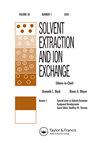N, N, N ', N ', N ', N ', N ' -六辛基-硝基三乙酰胺萃取-电沉积法回收钯
IF 2.1
4区 化学
Q3 CHEMISTRY, MULTIDISCIPLINARY
引用次数: 0
摘要
摘要开发钯的溶剂萃取(SX)和电沉积(ED)工艺以减少酸和有机介质的体积是至关重要的。本研究以N,N,N’,N’’,N“,N”-六辛基次氮基三乙酰胺(NTA酰胺(C8))为新型萃取剂,在氯化物介质中萃取钯(II)。三种具有高介电常数的稀释剂(苯乙酮(AP)、1,2-二氯乙烷(DCE)和1-辛醇(OC))用于溶剂萃取反应。斜率分析表明,对于NTA酰胺(C8)/AP和NTA酰胺/DCE系统,Pd(II)的阴离子交换萃取反应与大约2:1的化学计量一致,而对于NTA胺(C8。此外,使用循环伏安法(CV)研究了提取的Pd(II)络合物的ED行为。根据对标准速率常数的分析,发现钯还原是一个不可逆的过程。伏安图的半积分分析确定,提取的Pd(II)络合物在AP、DCE和OC系统中的扩散系数分别为3.7±0.1×10−10、2.8±0.1×10−10和1.5±0.2×10−10m2s−1。此外,使用NTA酰胺(C8)/AP系统进行连续萃取-电沉积工艺五个循环。在所有循环中都获得了较高的萃取率(E>91%)和电流效率(ε>83.1%)。通过X射线光电子能谱(XPS)和X射线衍射(XRD)分析,从萃取-电沉积过程中回收的电沉积被鉴定为Pd金属。本文章由计算机程序翻译,如有差异,请以英文原文为准。
Recovery of Palladium by Extraction-electrodeposition Using N, N, N’, N’, N”, N”- Hexaoctyl-nitrilotriacetamide
ABSTRACT It is essential to develop solvent extraction (SX), and electrodeposition (ED) processes for palladium to reduce the volume of acid and organic media. In this study, the extraction reaction of Pd(II) in chloride media using of N, N, N’, N’, N”, N”-hexaoctyl-nitrilotriacetamide (NTAamide(C8)) as a novel extractant has been demonstrated. Three diluents with high dielectric constants (acetophenone (AP), 1,2-dichloroethane (DCE), and 1-octanol (OC)) were used for the solvent extraction reaction. The slope analysis indicated that the anion exchange extraction reaction of Pd(II) was consistent with an approximately 2:1 stoichiometry for the NTAamide(C8)/AP and NTAamide(C8)/DCE systems, and 1:1 for NTAamide(C8)/OC. Moreover, the ED behavior of the extracted Pd(II) complex was investigated using cyclic voltammetry (CV). Palladium reduction was found to be an irreversible process based on analysis of the standard rate constant. A semi-integral analysis of the voltammogram determined the diffusion coefficients of the extracted Pd(II) complex in the AP, DCE, and OC systems to be 3.7 ± 0.1 × 10−10, 2.8 ± 0.1 × 10−10 and 1.5 ± 0.2 × 10−10 m2 s−1, respectively. Furthermore, consecutive extraction-electrodeposition processes using the NTAamide(C8)/AP system were carried out for five cycles. High extraction percentage (E > 91%) and current efficiency (ε > 83.1%) were attained in all cycles. The electrodeposits recovered from the extraction-electrodeposition process were identified as Pd metal through X-ray photoelectron spectroscopy (XPS) and X-ray diffraction (XRD) analyses.
求助全文
通过发布文献求助,成功后即可免费获取论文全文。
去求助
来源期刊
CiteScore
4.40
自引率
5.00%
发文量
15
审稿时长
8.4 months
期刊介绍:
Solvent Extraction and Ion Exchange is an international journal that publishes original research papers, reviews, and notes that address all aspects of solvent extraction, ion exchange, and closely related methods involving, for example, liquid membranes, extraction chromatography, supercritical fluids, ionic liquids, microfluidics, and adsorption. We welcome submissions that look at: The underlying principles in solvent extraction and ion exchange; Solvent extraction and ion exchange process development; New materials or reagents, their syntheses and properties; Computational methods of molecular design and simulation; Advances in equipment, fluid dynamics, and engineering; Interfacial phenomena, kinetics, and coalescence; Spectroscopic and diffraction analysis of structure and dynamics; Host-guest chemistry, ion receptors, and molecular recognition.

 求助内容:
求助内容: 应助结果提醒方式:
应助结果提醒方式:


